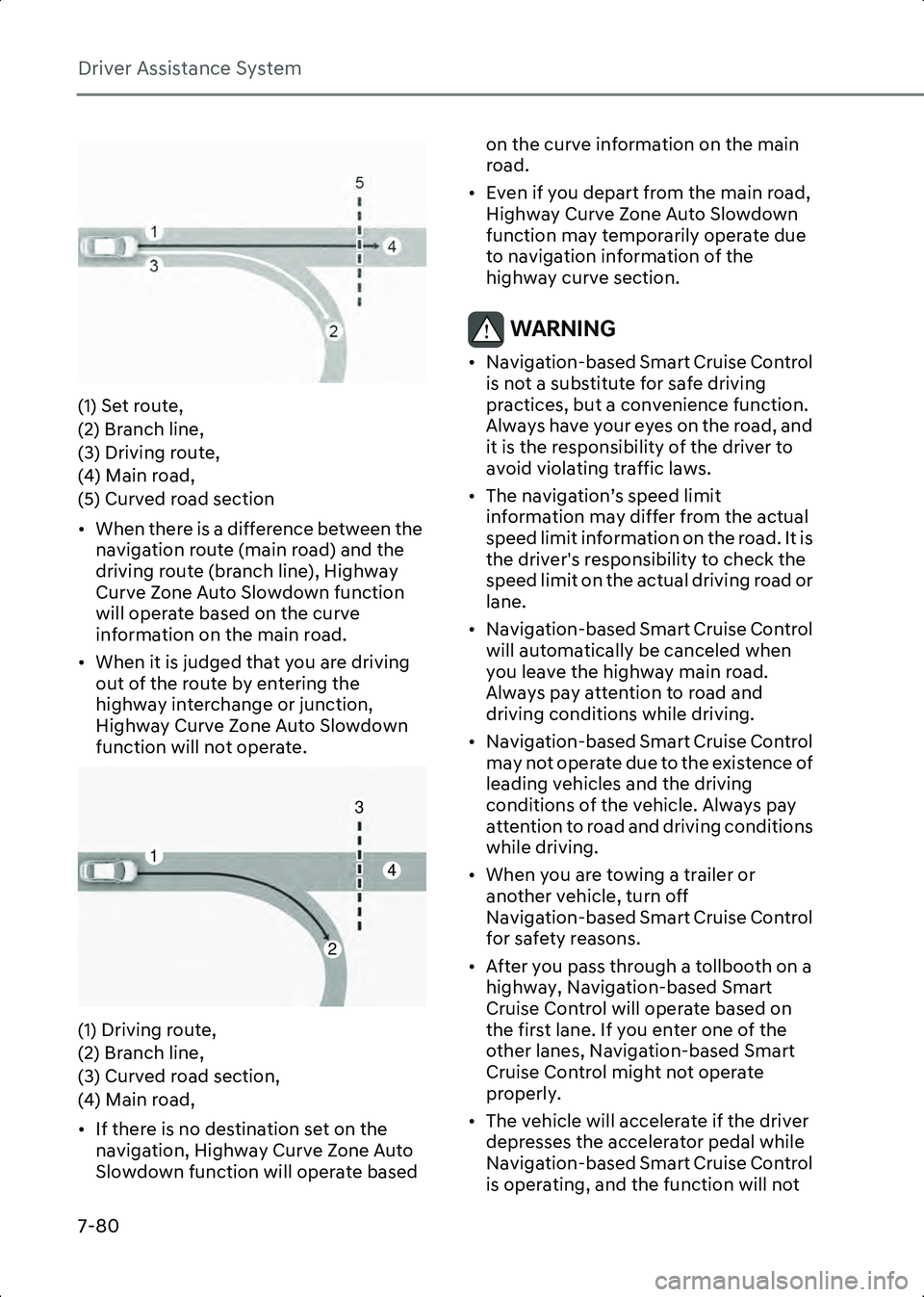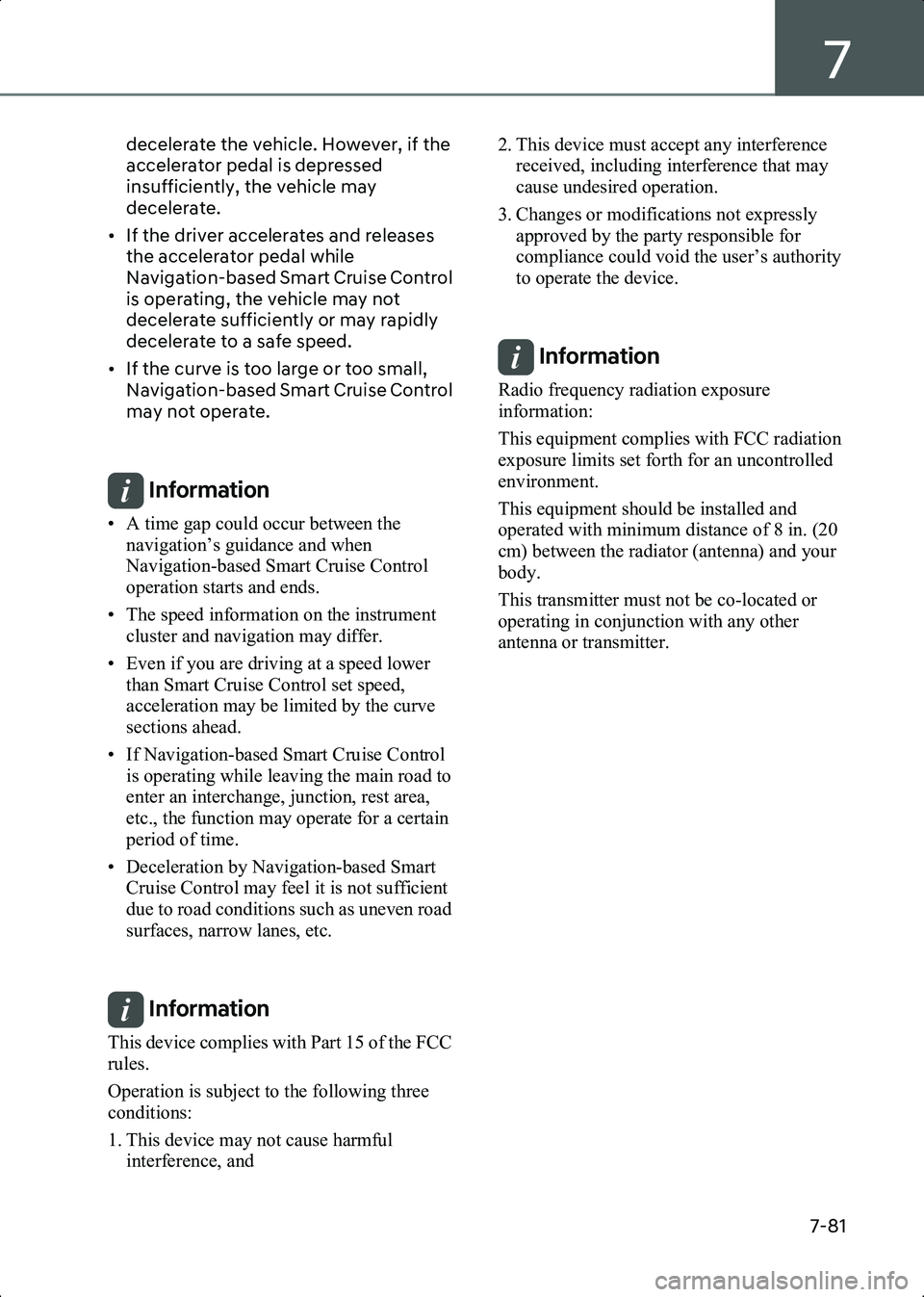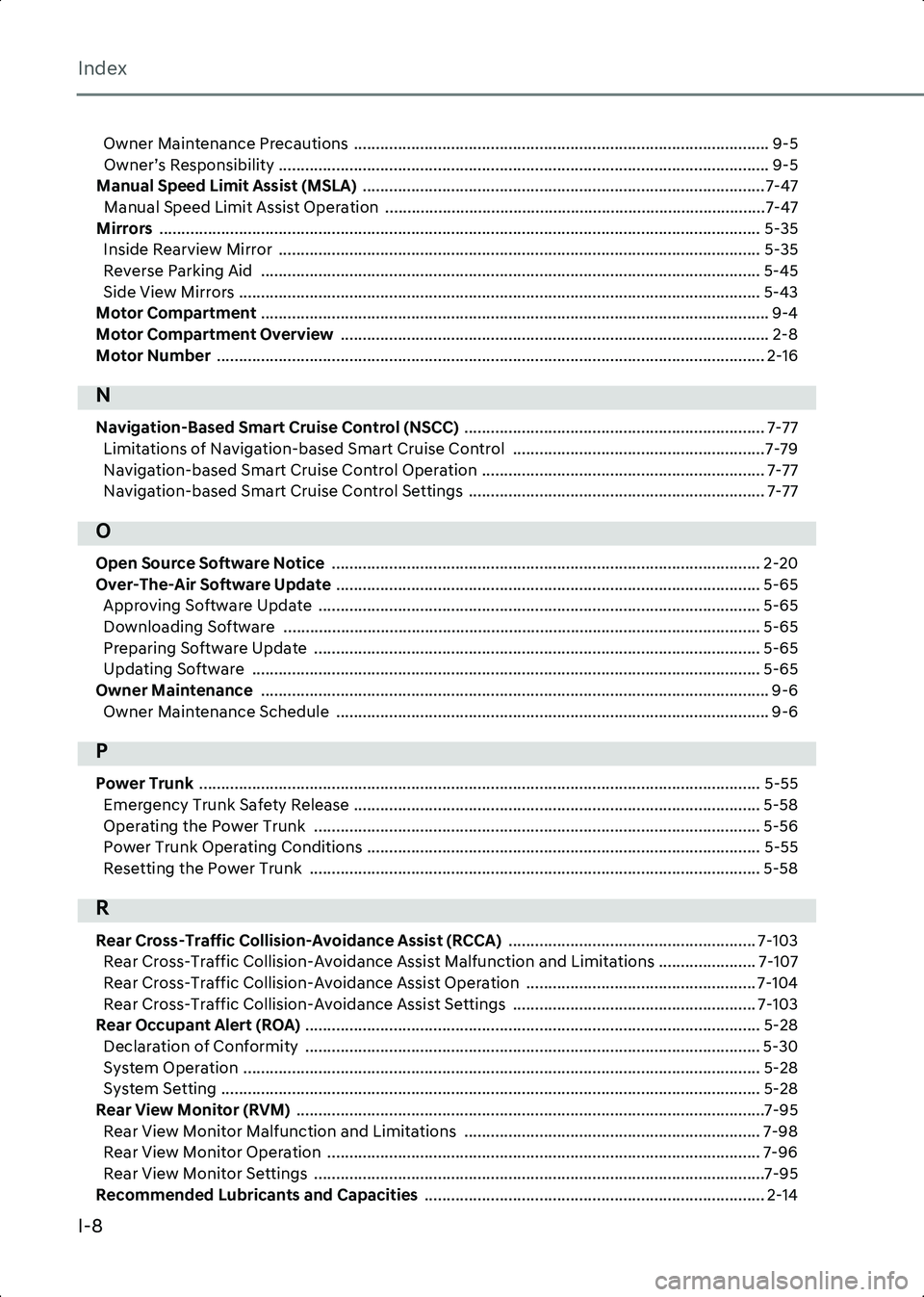2023 HYUNDAI IONIQ 6 navigation
[x] Cancel search: navigationPage 423 of 582

7
7-79
Limitations of
Navigation-based Smart
Cruise Control
Navigation-based Smart Cruise Control
may not operate properly under the
following circumstances:
• The navigation is not working properly
• Map information is not transmitted due to infotainment system's abnormal
operation
• Speed limit and road information in the navigation is not updated
• The map information and the actual road is different because of real-time
GPS data or map information error
• The navigation searches for a route while driving
• GPS signals are blocked in areas such as a tunnel
• A road that divides into two or more roads and joins again
• The driver goes off course from the route set in the navigation
• The route to the destination is changed or cancelled by resetting the navigation
• The vehicle enters a service station or rest area
• Android Auto or Car Play is operating
• The navigation cannot detect the current vehicle position (for example,
elevated roads including overpass
adjacent to general roads or nearby
roads exist in a parallel way)
• The navigation is being updated while driving
• The navigation is being restarted while driving
• The speed limit of some sections changes according to the road
situations
• Driving on a road under construction
• Driving in lane-restricted driving situations • There is bad weather, such as heavy
rain, heavy snow, etc.
• Driving on a road that is sharply curved
B7004801(1) Set route,
(2) Branch line,
(3) Driving route,
(4) Main road,
(5) Curved road section
• When there is a difference between the navigation set route (branch line) and
the driving route (main road), Highway
Curve Zone Auto Slowdown function
may not operate until the driving route
is recognized as the main road.
• When the vehicle's driving route is recognized as the main road by
maintaining the main road instead of
the navigation set route, Highway
Curve Zone Auto Slowdown function
will operate. Depending on the distance
to the curve and the current vehicle
speed, vehicle deceleration may not be
sufficient or may decelerate rapidly.
Hyundai_CE_en_US.book Page 79
Page 424 of 582

Driver Assistance System
7-80
B7004802(1) Set route,
(2) Branch line,
(3) Driving route,
(4) Main road,
(5) Curved road section
• When there is a difference between the navigation route (main road) and the
driving route (branch line), Highway
Curve Zone Auto Slowdown function
will operate based on the curve
information on the main road.
• When it is judged that you are driving out of the route by entering the
highway interchange or junction,
Highway Curve Zone Auto Slowdown
function will not operate.
B7004803(1) Driving route,
(2) Branch line,
(3) Curved road section,
(4) Main road,
• If there is no destination set on the navigation, Highway Curve Zone Auto
Slowdown function will operate based on the curve information on the main
road.
• Even if you depart from the main road, Highway Curve Zone Auto Slowdown
function may temporarily operate due
to navigation information of the
highway curve section.
WARNING • Navigation-based Smart Cruise Control is not a substitute for safe driving
practices, but a convenience function.
Always have your eyes on the road, and
it is the responsibility of the driver to
avoid violating traffic laws.
• The navigation’s speed limit information may differ from the actual
speed limit information on the road. It is
the driver's responsibility to check the
speed limit on the actual driving road or
lane.
• Navigation-based Smart Cruise Control will automatically be canceled when
you leave the highway main road.
Always pay attention to road and
driving conditions while driving.
• Navigation-based Smart Cruise Control may not operate due to the existence of
leading vehicles and the driving
conditions of the vehicle. Always pay
attention to road and driving conditions
while driving.
• When you are towing a trailer or another vehicle, turn off
Navigation-based Smart Cruise Control
for safety reasons.
• After you pass through a tollbooth on a highway, Navigation-based Smart
Cruise Control will operate based on
the first lane. If you enter one of the
other lanes, Navigation-based Smart
Cruise Control might not operate
properly.
• The vehicle will accelerate if the driver depresses the accelerator pedal while
Navigation-based Smart Cruise Control
is operating, and the function will not
2
4
3
1
Hyundai_CE_en_US.book Page 80
Page 425 of 582

7
7-81
decelerate the vehicle. However, if the
accelerator pedal is depressed
insufficiently, the vehicle may
decelerate.
• If the driver accelerates and releases the accelerator pedal while
Navigation-based Smart Cruise Control
is operating, the vehicle may not
decelerate sufficiently or may rapidly
decelerate to a safe speed.
• If the curve is too large or too small, Navigation-based Smart Cruise Control
may not operate.
Information • A time gap could occur between the navigation’s guidance and when
Navigation-based Smart Cruise Control
operation starts and ends.
• The speed information on the instrument cluster and navigation may differ.
• Even if you are driving at a speed lower than Smart Cruise Control set speed,
acceleration may be limited by the curve
sections ahead.
• If Navigation-based Smart Cruise Control is operating while leaving the main road to
enter an interchange, junction, rest area,
etc., the function may operate for a certain
period of time.
• Deceleration by Navigation-based Smart Cruise Control may feel it is not sufficient
due to road conditions such as uneven road
surfaces, narrow lanes, etc.
Information This device complies with Part 15 of the FCC
rules.
Operation is subject to the following three
conditions:
1. This device may not cause harmful interference, and 2. This device must accept any interference
received, including interference that may
cause undesired operation.
3. Changes or modifications not expressly approved by the party responsible for
compliance could void the user’s authority
to operate the device.
Information Radio frequency radiation exposure
information:
This equipment complies with FCC radiation
exposure limits set forth for an uncontrolled
environment.
This equipment should be installed and
operated with minimum distance of 8 in. (20
cm) between the radiator (antenna) and your
body.
This transmitter must not be co-located or
operating in conjunction with any other
antenna or transmitter.
Hyundai_CE_en_US.book Page 81
Page 430 of 582

Driver Assistance System
7-86
Information • Highway Driving Assist is available only on controlled access road of certain
highways.
- Controlled access road indicates roads with limited entrances and exits that
allow uninterrupted high speed traffic
flow. Only passenger cars and
motorcycles are allowed on controlled
access roads.
• Additional highways may be expanded by future navigation updates.
Information Highway Driving Assist operates on main
roads of highways, and does not operate on
interchanges or junctions.
Detecting sensor
B7005303
B7005304
B7005305
(1) Front view camera,
(2) Front radar,
(3) Front corner radar (if equipped),
(4) Rear corner radar (if equipped)
Refer to the picture above for the detailed
location of the detecting sensors.
Available Highway (Controlled access road) USA Select Interstate
Highway and U.S.
(Federal) and State Highways
Canada Select Provincial and
Territorial Highways
1
3
32
44
Hyundai_CE_en_US.book Page 86
Page 438 of 582

Driver Assistance System
7-94
Highway Driving Assist may not detect
possible collisions due to limitations of
the function. Always be aware of the
limitations of the function. Obstacles
such as vehicles, motorcycles, bicycles,
pedestrians, or unspecified objects or
structures such as guardrails, tollbooth,
etc., that may collide with the vehicle
may not be detected.
• Highway Driving Assist will turn off automatically under the following
situations:
- Driving on roads that Highway Driving Assist does not operate, such
as a rest area, intersection, junction,
etc.
- The navigation does not operate properly such as when the navigation
is being updated or restarted
• Highway Driving Assist may inadvertently operate or turn off
depending on road conditions
(navigation information) and
surroundings.
• Lane Following Assist function may be temporarily disabled when the front
view camera cannot detect lanes
properly or the hands-off warning is on.
• You may not hear the warning sound of Highway Driving Assist if the
surrounding is noisy.
• If the vehicle is driven at high speed above a certain speed at a curve, your
vehicle may drive to one side or may
depart from the driving lane.
• When you are towing a trailer or another vehicle, turn off Highway
Driving Assist for safety reasons.
• The hands-off warning message may appear early or late depending on how
the steering wheel is held or road
conditions. Always have your hands on
the steering wheel while driving.
• For your safety, please read the owner's manual before using the Highway
Driving Assist. • Highway Driving Assist will not operate
when the vehicle is started, or when the
detecting sensors or navigation is being
initialized.
Limitation of Highway Driving Assist
Highway Driving Assist and Highway Lane
Change function may not operate
properly, or may not operate under the
following circumstances:
• The map information and the actual road is different because the navigation
is not updated
• The map information and the actual road is different because of real-time
GPS data or map information error
• The infotainment system is overloaded by simultaneously performing
functions such as route search, video
playback, voice recognition, etc.
• GPS signals are blocked in areas such as a tunnel
• The driver goes off course or the route to the destination is changed or
canceled by resetting the navigation
• The vehicle enters a service station or rest area
• Android Auto or Car Play is operating
• The navigation cannot detect the current vehicle position (for example,
elevated roads including overpass
adjacent to general roads or nearby
roads exist in a parallel way)
• White single dotted lane line or road edge cannot be detected
• The road is temporarily controlled due to construction, etc.
• There is no structure, such as a medium strip, guardrails, etc., on the road
• There is a changeable lane in the direction of lane change
• If a trailer, carrier, etc., is installed
Hyundai_CE_en_US.book Page 94
Page 578 of 582

Index
I-8
Owner Maintenance Precautions .............................................................................................. 9-5Owner’s Responsibility ............................................................................................................... 9-5
Manual Speed Limit Assist (MSLA) ........................................................................................... 7-47
Manual Speed Limit Assist Operation ......................................................................................7-47
Mirrors ........................................................................................................................................ 5-35 Inside Rearview Mirror ............................................................................................................. 5-35
Reverse Parking Aid ................................................................................................................. 5-45
Side View Mirrors ...................................................................................................................... 5-43
Motor Compartment ................................................................................................................... 9-4
Motor Compartment Overview ................................................................................................. 2-8
Motor Number ............................................................................................................................ 2-16
N
Navigation-Based Smart Cruise Control (NSCC) .................................................................... 7-77
Limitations of Navigation-based Smart Cruise Control ......................................................... 7-79
Navigation-based Smart Cruise Control Operation ................................................................ 7-77
Navigation-based Smart Cruise Control Settings ................................................................... 7-77
O
Open Source Software Notice ................................................................................................. 2-20
Over-The-Air Software Update ................................................................................................ 5-65
Approving Software Update .................................................................................................... 5-65
Downloading Software ............................................................................................................ 5-65
Preparing Software Update ..................................................................................................... 5-65
Updating Software ................................................................................................................... 5-65
Owner Maintenance ................................................................................................................... 9-6
Owner Maintenance Schedule .................................................................................................. 9-6
P
Power Trunk ............................................................................................................................... 5-55
Emergency Trunk Safety Release ............................................................................................ 5-58
Operating the Power Trunk ..................................................................................................... 5-56
Power Trunk Operating Conditions ......................................................................................... 5-55
Resetting the Power Trunk ...................................................................................................... 5-58
R
Rear Cross-Traffic Collision-Avoidance Assist (RCCA) ........................................................ 7-103
Rear Cross-Traffic Collision-Avoidance Assist Malfunction and Limitations ...................... 7-107
Rear Cross-Traffic Collision-Avoidance Assist Operation .................................................... 7-104
Rear Cross-Traffic Collision-Avoidance Assist Settings ....................................................... 7-103
Rear Occupant Alert (ROA) ....................................................................................................... 5-28
Declaration of Conformity ....................................................................................................... 5-30
System Operation ..................................................................................................................... 5-28
System Setting .......................................................................................................................... 5-28
Rear View Monitor (RVM) ..........................................................................................................7-95
Rear View Monitor Malfunction and Limitations ................................................................... 7-98
Rear View Monitor Operation .................................................................................................. 7-96
Rear View Monitor Settings ......................................................................................................7-95
Recommended Lubricants and Capacities ............................................................................. 2-14
Hyundai_CE_en_US.book Page 8